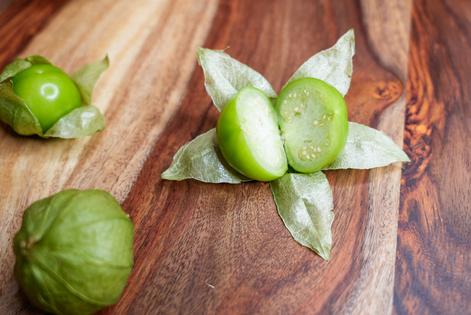Tomatillos are the secret to summer soups, sauces and salads
Published in Health & Fitness
If you’ve ever had the pleasure of eating Mexican chile verde or salsa verde, you’ve probably experienced the tangy, fruity flavor of the tomatillo. While they’re often mistaken for green tomatoes, tomatillos are different fruits entirely. Here, we’ll tell you what they are and how to prepare them.
What are tomatillos?
Also known as jam berries and Mexican husk tomatoes, tomatillos are small, round fruits green in color that are members of the nightshade family (or Solanaceae), much like bell peppers, eggplant, and tomatoes. Native to Mexico, these little fruits resemble green tomatoes and grow on vines like tomatoes, only they come shrouded in husks — a papery shell that shields the shiny green skin of the fruit from the elements. They’re actually more similar to cape gooseberries (which also have husks) than tomatoes–raw tomatillos have a slightly tart flavor with tropical notes and hints of green apple, while raw green tomatoes are a bit bland.
How to prepare tomatillos
Preparing fresh tomatillos is easy. Remove the stem and husk–if you pinch it, it should come off fairly easily. The fruit underneath the shell will have a sticky film on it. That can be rinsed off with warm water. Some people use a little bit of soap, or they actually scrub off the film, but it’s not necessary if you’re using it in hot dishes — it cooks off when you boil or roast it.
If you’re using them for salad or cold dishes, they’re ready to cut and mix after being cleaned. If you’re roasting or boiling them, it’s best to leave them whole.
How to cook tomatillos
This little fruit is a staple of Mexican cooking. Boiled or roasted, tomatillos are the base for salsa verde and other green sauces, but they can be used in any number of dishes, both raw and cooked–green gazpacho, chile verde, salad dressing, and salad. Though you can find them in most grocery stores year-round, the season starts in June and goes through fall, so they work well in summer dishes.
If you’re making salsa verde (essentially tomatillo salsa), the traditional method is to boil the fruit with jalapeños and then blend them with raw onion and cilantro. However, if you want deeper flavors in your sauce, you can roast them with the peppers and onions as an alternative–the results of the methods are different flavor experiences, but both are delicious.
Buying
Tomatillos are sold with the papery husks still on them. You know they’re ripe if the husk is broken–the fruit grows faster than the husk, and it breaks the shell when it’s ready to be eaten. When you peel the husk, the skin should be bright green, blemish-free, and shiny. The fruit should be fairly firm, but not rock hard.
Storing
Store tomatillos with the husk intact in a loose paper bag in a cool, dark place. They can be stored in the refrigerator for about two weeks, but like tomatoes, they like temperatures about 20 degrees warmer than the refrigerator, so keep that in mind when you’re doing your meal planning.
Nutrition facts
While tomatillos deliver a lot of flavor, they’re mostly water. That means they’re low in calories–a half-cup serving is about 21 calories, and a few nutrients to note: vitamin C, vitamin K, potassium, magnesium, fiber.
(EatingWell is a magazine and website devoted to healthy eating as a way of life. Online at www.eatingwell.com.)
©2025 Dotdash Meredith. All rights reserved. Used with permission. Distributed by Tribune Content Agency, LLC.










Comments